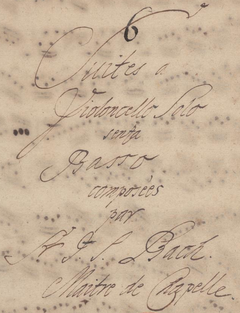Cello Suites (Bach)
| Cello Suites | |
|---|---|
| BWV 1007 to 1012 | |
| by J. S. Bach | |

Title page of Anna Magdalena Bach's manuscript: Suites á Violoncello Solo senza Basso
|
|
| Composed | between 1717 and 1723 |
| Instrumental | Cello solo |
The six Cello Suites, BWV 1007 to 1012, are suites for unaccompanied cello by Johann Sebastian Bach. They are some of the most frequently performed and recognizable solo compositions ever written for cello. Bach most likely composed them during the period 1717–23, when he served as a Kapellmeister in Köthen. The title of the Anna Magdalena Bach manuscript was Suites à Violoncello Solo senza Basso (Suites for cello solo without bass).
These suites for unaccompanied cello are remarkable in that they achieve the effect of implied three- to four-voice contrapuntal and polyphonic music in a single musical line. As usual in a Baroque musical suite, each movement is based around a baroque dance type; the cello suites are structured in six movements each: prelude, allemande, courante, sarabande, two minuets or two bourrées or two gavottes, and a final gigue. The Bach cello suites are considered to be among the most profound of all classical music works.Wilfrid Mellers described them in 1980 as "Monophonic music wherein a man has created a dance of God."
Due to the works' technical demands, étude-like nature, and difficulty in interpretation because of the non-annotated nature of the surviving copies, the cello suites were little known and rarely publicly performed until they were revived and recorded by Pablo Casals in the early 20th century. They have since been performed and recorded by many renowned cellists, have also been transcribed for numerous other instruments, and are considered some of Bach's greatest musical achievements.
...
Wikipedia
